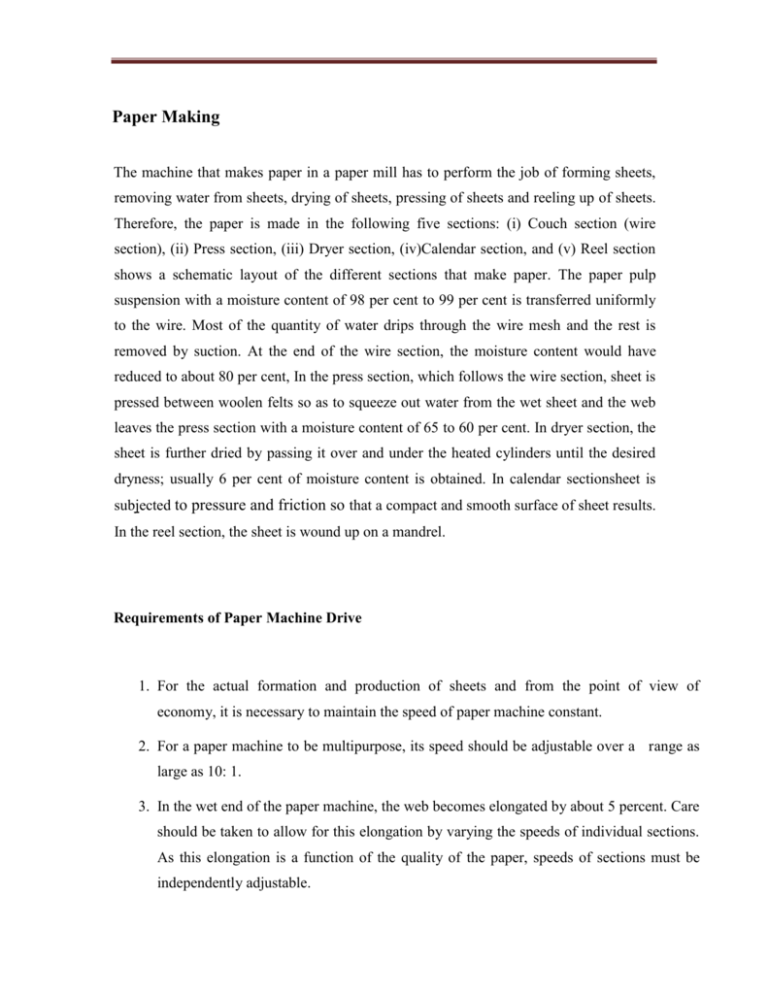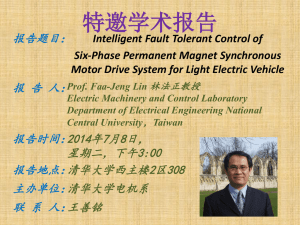paper machine
advertisement

Paper Making The machine that makes paper in a paper mill has to perform the job of forming sheets, removing water from sheets, drying of sheets, pressing of sheets and reeling up of sheets. Therefore, the paper is made in the following five sections: (i) Couch section (wire section), (ii) Press section, (iii) Dryer section, (iv)Calendar section, and (v) Reel section shows a schematic layout of the different sections that make paper. The paper pulp suspension with a moisture content of 98 per cent to 99 per cent is transferred uniformly to the wire. Most of the quantity of water drips through the wire mesh and the rest is removed by suction. At the end of the wire section, the moisture content would have reduced to about 80 per cent, In the press section, which follows the wire section, sheet is pressed between woolen felts so as to squeeze out water from the wet sheet and the web leaves the press section with a moisture content of 65 to 60 per cent. In dryer section, the sheet is further dried by passing it over and under the heated cylinders until the desired dryness; usually 6 per cent of moisture content is obtained. In calendar sectionsheet is subjected to pressure and friction so that a compact and smooth surface of sheet results. In the reel section, the sheet is wound up on a mandrel. Requirements of Paper Machine Drive 1. For the actual formation and production of sheets and from the point of view of economy, it is necessary to maintain the speed of paper machine constant. 2. For a paper machine to be multipurpose, its speed should be adjustable over a range as large as 10: 1. 3. In the wet end of the paper machine, the web becomes elongated by about 5 percent. Care should be taken to allow for this elongation by varying the speeds of individual sections. As this elongation is a function of the quality of the paper, speeds of sections must be independently adjustable. In dry end of paper machine, the web hangs freely between sections without any support. Therefore, a definite amount of tension must be set and regulated. This also necessitates a definite difference between the speed. of successive sections. The relative speeds of two sections have a direct bearing on the pull on the sheet. Hence, steady state accuracy of 0.1 per cent or better is specified for the speed control system so as to avoid tearing and folding of sheet. 4. As web is manually introduced into the calendar, an arrangement to take up sag is a must. 5. In the last two sections, viz., the calendar and the reel, variations in tension in sheet can occur even if the correct relative speeds are maintained due to uneven drying and other factors. It is, therefore, imperative to augment the speed control circuit by an overriding tension control. 6. While cleaning the wire, it has to be moved forward a few centimeters at a time so that it can be cleaned and inspected properly. Hence, the motor should be capable of running at inching speeds of 10.25 m/min as long as a particular button is pressed. 7. Each section should be able to run at the crawling speed of 10-25 m/min for running in felts, wire and heating up of dryer cylinders. 8. Smooth and quick starting of the sections, without causing -excessive starting is required. 9. Control system employed should be flexible in nature. Types of Drives Used for Paper Machine There are two types of drives employed for making paper from pulp line shaft drive and sectional drive. Line shaft drives; In this form of drive, the various sections of the paper machine are driven from a line shaft running the full length of paper machine. Cone pulleys and belt-combinations drive the various sections of the machine from line shaft through right angled gear reductions. Normally, electric motors are employed to drive the transmission shaft. Both ac and dc drives can be used for practically loss-less speed control. In ac drive only the ac commutator motor with shunt characteristic is of use for obtaining an economic speed control system. Its advantage is in the possibility of current, connecting the motor directly to a three phase supply, thereby eliminating an ac-dc converter, which would be required if a dc drive were used. However, the speed of an ac commutator motor depends on load and, hence, its use as a paper machine drive with stringent requirements of constant speed is no longer advisable. Also, its speed range (usually of the order 1: 3) as well as the power required greatly affects the size of the motor. The open loop speed control of the ac commutator motor is sluggish in comparison with a dc drive, as speed is varied by adjusting an induction regulator and shifting the brush rocker. In de drives, the speed of the paper machine is controlled by varying the armature voltage of a separately excited dc motor. The variable de voltage is obtained from alternating voltage supply by means of either rotary conveners or static converters. Sectional drives: In sectional drive each section of the paper machine has its own electrical motor, All the motors arc operated from a common supply bus. By varying bus bar voltage, the speed of the paper machine can be controlled. By adjusting the field excitation of any motor, it is possible to vary the speed of that particular motor with respect to other motors.






